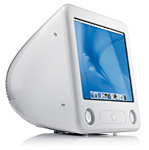If your wallet has prevented you from trading in that old G3 or
Power Mac for a new top-o-the-line G4, your wait is over. The new
eMac adds G4 power to
Apple's consumer line of Macs.
The eMac was introduced in April, amid much fanfare, as an
"education only" model. Featuring a 700 MHz G4 processor, a 17" CRT
display, and starting at $999, the eMac represented the most bang for
the buck in the entire Apple lineup. Several weeks ago, responding to
consumer demand, Apple made the eMac available for purchase by
anyone.
All models include a 40 GB Ultra ATA hard drive, Nvidia GeForce 2 MX
with 32 MB of DDR SDRAM video supporting resolutions of up to  1280 x 960, two FireWire and three USB ports, 128 MB of
RAM (expandable to 1 GB), a 100 MHz system bus, a 256k on-chip level 2
cache that runs at processor speed, built-in 10/100 Base-T ethernet, an
Apple Pro keyboard and mouse, and are AirPort-ready.
1280 x 960, two FireWire and three USB ports, 128 MB of
RAM (expandable to 1 GB), a 100 MHz system bus, a 256k on-chip level 2
cache that runs at processor speed, built-in 10/100 Base-T ethernet, an
Apple Pro keyboard and mouse, and are AirPort-ready.
The $999 education-only base model does not have a modem and has a
32x CD-ROM drive; the $1,199 education model has a DVD-ROM/CD-RW combo
drive and a 56k modem. The consumer-only $1,099 model ships with a
24x10x32x CD-RW and a 56k modem.
Apple has not scrimped on the extras, as all models also feature an
internal 16-watt digital amplifier, a built-in microphone for speech
recognition and audio recording, a mini headphone jack, an analog audio
input minijack, a video mini-VGA output port, and support for video
mirroring (an external display's image is identical to that shown on
the built-in display).
I tested a consumer model that had been upgraded to 256 MB of RAM; I
later spent some time with another eMac that had only the standard 128
MB of memory.
The first thing you notice when you sit down in front of the eMac is
how much extra screen real estate the 17" display provides over the
iMac's 15" monitor. Even set at the maximum resolution of 1280 x 960,
the display is clear and crisp and does not strain the eyes.
The next thing you realize is that the G4 is noticeably faster than
the G3 at the same MHz (but then, that is why it is called the
Megahertz Myth). All programs launch faster than on a comparable G3.
Some applications, such as Connectix' VirtualPC, run several times
faster on a G4. I have never seen Windows95 run as fast as it does on a
G4/700. On the other hand, on a G3/600 iMac it can seem like Win95 is
actually running on a virtual 486.
Perhaps the most remarkable feature of the eMac is the fact that it
does not take up anymore desktop space than a 15" iMac and is, in fact,
slightly less deep than the original iMac. Advances in CRT technology,
coupled with Apple engineering savvy, have managed to pack more
features into less space. The eMac does, however, weigh a whopping 50
pounds, which is undoubtedly why, unlike the CRT iMac, it does not have
a "handle" built into the top of the case.
The eMac's CD mechanism is operated via an eject button on the
keyboard. It does not have a manual eject button or even a paper clip
hole. Apple provides a laundry list of measures to try in case the
optical drive eject mechanism fails to operate. The only obvious method
of manual operation, however, is to flip down the door and yank on the
drive tray, a method we certainly do not recommend.
An upgrade of the standard 128 MB of RAM to at least 256 MB is
highly recommended. Although performance between the 128 MB and 256 MB
models was comparable while running a single program, there was
significant degradation of speed on the 128 MB model when multiple
programs were opened.
The eMac includes all the software you need to become productive
immediately. Mac OS X 10.1.x and OS 9.2 are pre-installed.
AppleWorks, QuickTime, iMovie 2, iPhoto, iTunes 2, Mac OS X Mail,
Microsoft Internet Explorer, AOL, Quicken 2002 Deluxe, and World Book
are all included as well.
Some commentators have criticized Apple for what they see as
"muddying" the product line with too many choices. I disagree. The eMac
fills at least two voids in Apple's product line. It provides high-end
G4 power to the education market for less than $1,000 per unit, and it
gives consumers an entry-level G4 for only $100 more than the high-end
G3 iMac. Maxed out with 1 GB of RAM, the eMac would be acceptable
even as a graphics workstation for the budget-minded.
More choices (within reason) = better.


 1280 x 960, two FireWire and three USB ports, 128 MB of
RAM (expandable to 1 GB), a 100 MHz system bus, a 256k on-chip level 2
cache that runs at processor speed, built-in 10/100 Base-T ethernet, an
Apple Pro keyboard and mouse, and are AirPort-ready.
1280 x 960, two FireWire and three USB ports, 128 MB of
RAM (expandable to 1 GB), a 100 MHz system bus, a 256k on-chip level 2
cache that runs at processor speed, built-in 10/100 Base-T ethernet, an
Apple Pro keyboard and mouse, and are AirPort-ready.
